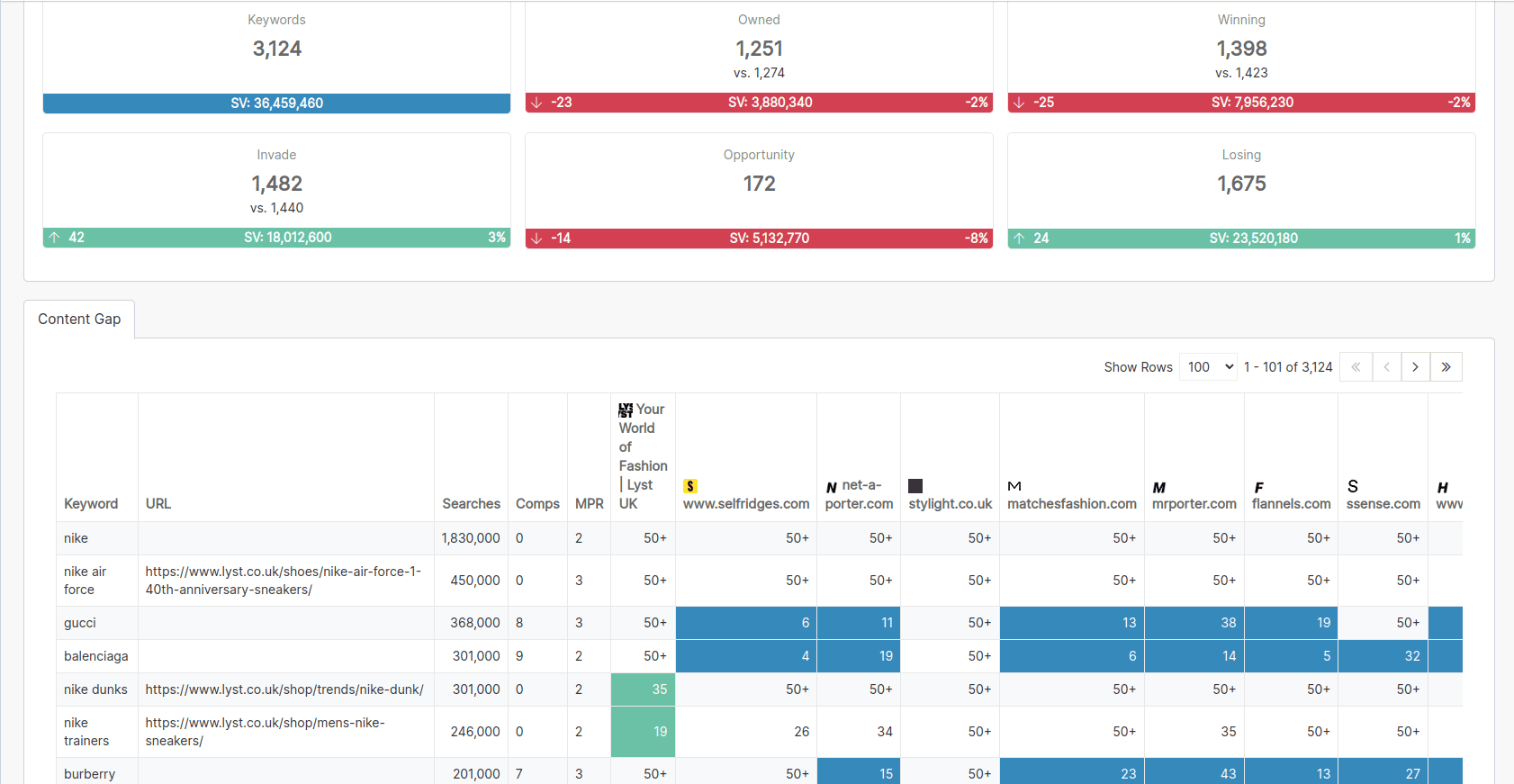Happy New Year!
2022 was a whirlwind year in many ways for us at DemandSphere, and I’m sure the same was true for you as well.
This is a quick post to highlight the top feature updates among more than three dozen major updates we made to our platform in 2022.
As always, our goal is combine the following value-adds for our customers in our platform:
- Ease of use
- The most advanced enterprise features & APIs
- The best pricing for value
While we don’t claim to be 100% successful in all three all the time, this is the mission that gets us cranking hard every day.
2023 will be no different as we have even more great things planned.
Without further ado, here is a list of the top feature updates and releases we brought to our customers in 2022:
- True Keywords – Getting the most keywords from Google Search Console
- Search Intent
- Simple and Advanced Forecasting
- CTR Lab
- Pixels on all keyword rankings
- Visual Rank
- Turn-key data warehousing (in BigQuery and more)
- SERP Intelligence
- New v5 API (Beta)
- 360 Degree Content Insights
- Content Gap
- SERP Rewind Updates
- Sitemap monitoring
- Search volume inflation detection and data-cleaning pipelines
- Large keyword database expansions
- Competitor Discovery Improvements
- URL status and presence within ranking data
DemandSphere’s 2022 platform innovations:
#1: True Keywords – Getting the most keywords from Google Search Console
When we first launched DemandSphere one of our most-loved features was the pipeline view we had connecting Search Volume, organic search traffic at the keyword level, and search rankings.
Obviously, Google pulled that capability many years ago and SEOs have tried many ways to get a view back into that data.
On the Managed Services side of the house, we’ve offered this capability for years by mining customer’s Google Search Console (GSC) data to get a much larger amount of traffic driving keywords.
This helps to fill in the gaps between rankings, search volume estimates, and GSC itself.
We have been able to 500X the amount of keywords available for discovery and research based on the most relevant data our customers have: traffic and keywords directly from their own web properties.

One of our global customers found over 1,000,000 keywords in one market alone!
We are calling this feature True Keywords because, at long last, customers can once again see the true keywords that are driving traffic as well as keywords that could be driving much more traffic but for which the site is not fully optimized.
#2: Search Intents
Most of the better SEO platforms rolled out Search Intent categorization capabilities over the last 12-18 months and DemandSphere was no different.
As always, we like to put our own spin on things, so we look at both linguistic features of the keywords but also signals that we get from the SERP itself for clues on how Google might be categorizing these keywords. This also gives us the ability to categorize Search Intent for keywords per search engine tracked in our platform. This is helpful because you can get much more granular insights.
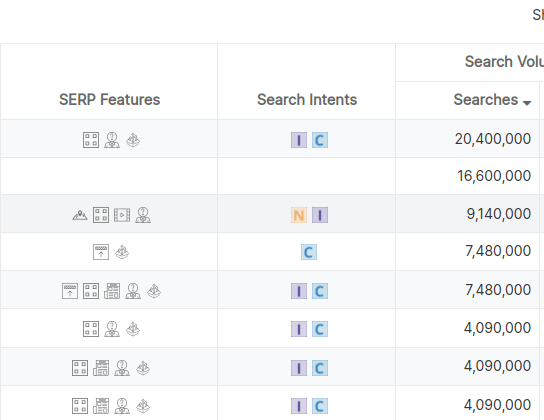
This granularity does add a layer of complexity however, and we found that most customers prefer a keyword-level categorization of Search Intent (without the search engine connection).
We listen closely to our customers and will be releasing an update in January to give users the option to choose the simplified view or more granular view, so you get the best of both worlds.
#3: Simple and Advanced Forecasting
In 2021, we added some basic forecasting capabilities to our platform.

In 2022, we added even more to this and there are some things that are so unique, we don’t even talk about them in public.
We require customers to sign an NDA to view these features due to the competitive nature of our market.
Suffice to say, we are now able to answer, at the click of a button, some of the most strategic and pressing questions for SEOs.
It goes beyond forecasting into true actionability but that is all I’m going to say here.
#4: CTR Lab (and GSC-driven CTR models)
The idea of forecasting traffic using the traditional multipliers in your CTR model * search volume is neither new, nor is it likely to go anywhere.
And, if we’re being honest, it’s far from ideal.
Anyone who has been in SEO for a long time understands this.
The only problem is, there aren’t many better alternatives. We do see increasing opportunities in using GSC data to solve some of these problems but, at the end of the day, the more data and the more angles you have on that data, the better equipped you’re going to be to build demand models.
So, naturally, SEOs continue to use CTRs from various sources.
Most advanced CTRs have built their own models and they want to use them in our platform, so one of the most commonly requested features was a way for users to create and use their own CTR models. In response to this request, we developed CTR Lab.
CTR Lab is one of our favorite new features because users can create not just one but any number of CTR models in the lab. They are easy to create visually and can be deployed instantly in all of your reporting and dashboards.
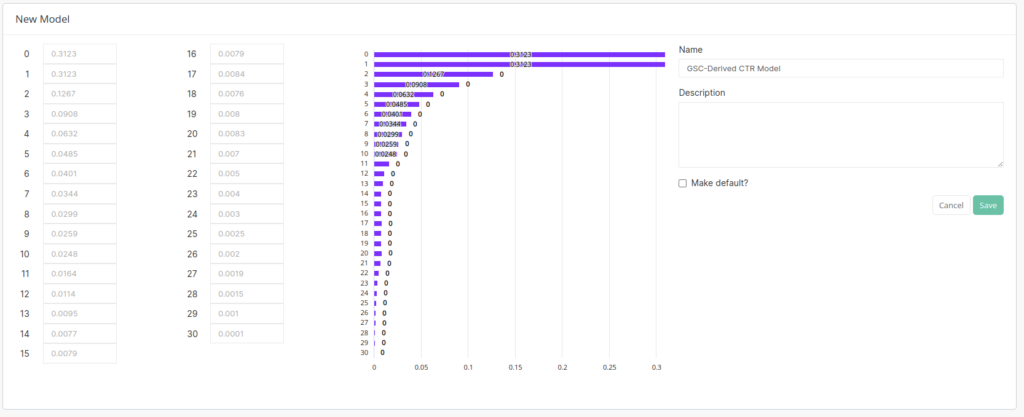
And our GSC-based True Keywords feature even provides another benefit: we now have data pipelines that can mine ALL of your keyword data and automatically generate the most relevant CTR models for you.
Because you’re able to create any number of CTR models, you can use our segmenting tools to build models on a keyword group basis and use that model as the basis for your reporting and forecasting in your custom dashboards.
#5: Pixel data for all keyword rankings
One of the key advances we’ve been wanting to make in the last few years has been to give our customers the ability to measure the visual impact of Google’s ongoing evolution of the SERP.
Specifically, as more and more of Google’s SERP Features push down the organic rankings, customers were wondering why their CTRs were dropping despite ranking better than they ever had been before. So we introduced pixel measurements.
There are only a handful of tools on the market that can even do this and, as always, we wanted to give it our own unique spin.
One of the things we’ve done is to add device / search engine specific pixel depths.

This means that while you can get the standard measurements out of the box in our platform, if you have an audience base that leans towards specific devices, search engine configurations, and browser configurations, you can even set up custom device profiles to get the most accurate pixel measurements possible.
#6: Visual Rank
Going right along with pixel measurements then is the idea of Visual Rank.
Again, a feature that only a handful of platforms in the market can even offer, we’re proud to be among that few.
We’ve rolled out our key data features for Visual Rank in Q4 and are going to be adding even more exciting visualizations of this data in Q1.
If you’re not familiar with this concept, we use pixel measurements as the basis for establishing a visual rank.
So, your organic rank might be 1 or 2, but because of all of the other features on the SERP, from a user’s perspective, you might be ranking #6, 7, or worse.

And, yet again, we take things to another level.
We also combine your visual ranking and pixel data with the True Keyword data we mine from GSC, giving you a complete view of not only your avg. position, impressions, and clicks, but also your organic rankings, visual rankings, pixel depths, search intent, and much more.
We’ve seen customers invest a lot of money in building their own internal data warehouses to do what we can provide in a single screen.
#7: Turn-key data warehousing in BigQuery (and more)
Speaking of data warehouses, we’ve got one ready to go for you. It covers a lot more than just what I mentioned in the previous section.
First, some technical background. We are truly living in the golden age of database technology. The amount of solutions available for data engineering and analysis workloads that have proliferated over the last 10-15 years is truly amazing to behold.
One of the biggest innovations we’ve adopted quite heavily is the fully-managed, serverless data warehouse, of which BigQuery is perhaps the best known.
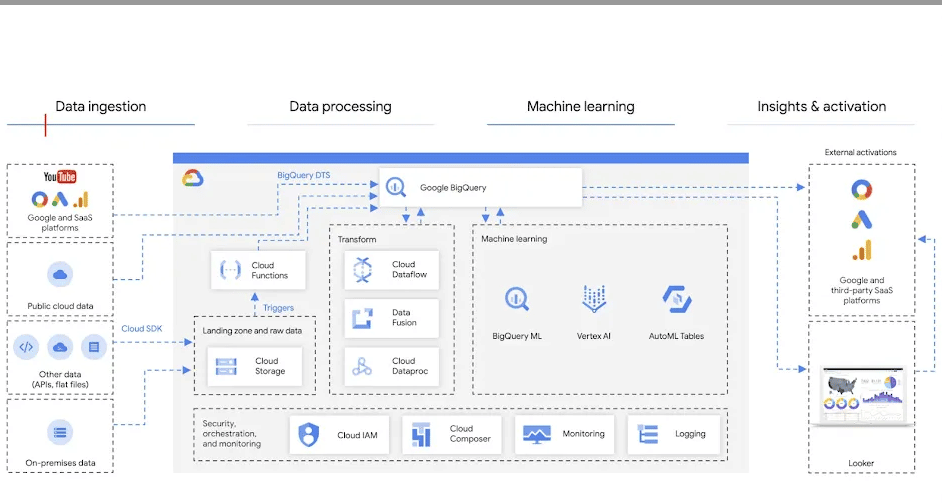
We continue to manage our own database infrastructure for our primary workloads, but BigQuery has become almost an ideal way to collaborate on data with external partners and clients. In many ways, it feels like a replacement to spreadsheets, although there are still plenty of use cases for those.
In the case of terabyte and petabyte sized datasets, however, BigQuery is hard to beat. There are other similar providers such as Snowflake, which we can also work with, but BQ is the one we’ve had the most customers interested in using.
With that background in place, what we’ve done is built an entire data warehouse management operation. In our experience with this, there are two types of customers, especially in the SEO / digital marketing world, that want this type of solution:
- They want it and have a data analysis team in place to use it properly without help
- They want it but don’t have a team in place to use it without help
It really just depends on the company, but the general trend we are seeing is the latter case. It’s really, really hard to hire teams that can properly use data warehousing tools but the insights you can derive from them are well-worth the investment. The data we provide gives customers a strong competitive edge, but they have to be able to use it.
In response to this latter case, we’ve boosted our Managed Services team in order to help customers get the insights they need without having to hire a whole team for it. We expect this need to continue to grow.
#8: SERP Intelligence
Now here is where things get really good.
Your first question after the previous section should be, ok, you have a data warehouse.
So, what’s in it?
The short answer is, whatever our customers need. We can get any data needed to answer the key questions in SEO, that’s not the hard part anymore.
The hard part is making it useful and turning these data pipelines into true operations.
In early 2020, we embarked on building a new product called SERP Intelligence.
The vision for it is simple, the implementation and operation for it is anything but simple.
The idea is this: Google is never going to stop adding more complexity to its SERPs. SEOs in our customer space are put in the position now of understanding every single element, down to the most minute detail, in order to understand how to optimize for the most space occupying the SERP. It sounds so easy to just build an index of all of these elements and store them in a database.
Where things quickly go off the rails is in QA / data accuracy. These SERP layouts are changing every day, Google is adding / deleting / modify according to their own whims so in order to get accurate and consistent data, we had to build an automated pipeline with very strict QA and accuracy checks. The output of SERP Intelligence is JSON but it also has syncing capabilities with the data warehouse of your choice. As mentioned before, BigQuery is the most common target destination for this.
It’s the larger companies who track tens or hundreds of thousands of keywords who really seem to benefit from this. Our larger customers, on average, monitor about 350K-1M SERPs daily in our platform., for multiple devices.
As you can probably imagine, being able to query the entirety of any element on these SERPs across all date ranges, groups, etc. is a much-desired and difficult prospect.
One of the nice side-benefits of having this dataset is that it is also extraordinarily valuable to paid search marketers as well.
Usually, all it takes is a single dashboard view of how we can easily group all the Shops from Shopping ads across tens of thousands or hundreds of thousands of keywords in a single view, segment by keyword groups to see ad copy, and more for paid search managers to immediately want access.
This is what we’ve built with SERP Intelligence and the 2023 roadmap for this product is going to be next-level.
#9: New v5 API (Beta)
This one is still in beta (hence the label) but 2022 saw a much-needed update to our API.
We will be releasing details on this to the public in the coming weeks and months, but we’ve completely rebuilt our API infrastructure.
The SERP Intelligence API is part of this but we also have APIs for:
- Reporting
- Automation
- Account & Site Management
- Integrations
- And even some new API-focused products
Our existing API (v3) will continue to be supported until we’re able to successfully upgrade all of our customers.
#10: 360 Degree Content Insights
Another big benefit of our work with GSC is in our Content Insights tool.
Content Insights within our platform has long been what we refer to as a “sleeper feature.”
It is very powerful but looks so boring, if we’re being honest.
But what it can do for you is, simply speaking, connect all of the keyword-focused SERP monitoring you’re doing back to the assets that actually impact those rankings: your pages and content.
With our True Keywords update, we’d able to build a 360 degree view of:
- any URL you choose to monitor (most of which are discovered automatically), including what we call Offsite Content (such as YouTube videos, partner content, etc.)
- any ad hoc segments / groups you’ve created for your content
- all of the keywords that your URLs rank for
- the performance of your URLs from a Preferred Landing Page (PLP) perspective, so you can avoid cannibalization
- connect your metrics from GSC and GA in the same view, so you can see every angle of your content performance. This enables you quickly spot pages that might be ranking well but perform poorly in terms of user / UX metrics, so you can take steps to avoid rank drops far earlier. It also enables you to monitor the economic value your content delivers.
In 2023, we have even more planned around this area of our platform because we’re seeing great results not just for SEO teams but also Content teams among our customer base.
Stay tuned.
#11: Content Gap
Once you get a hold of our Forecasting tools, one of your next questions will be, ok, what gaps do have in my Content Strategy?
We built Content Gap as a way to start answering these questions.
There are great Content Gap Tools in SEMRush and Ahrefs but these tend to focus more on whatever is in their (large) databases. We wanted something focused on answering the same questions for the highly curated lists of keywords that our customers monitor.
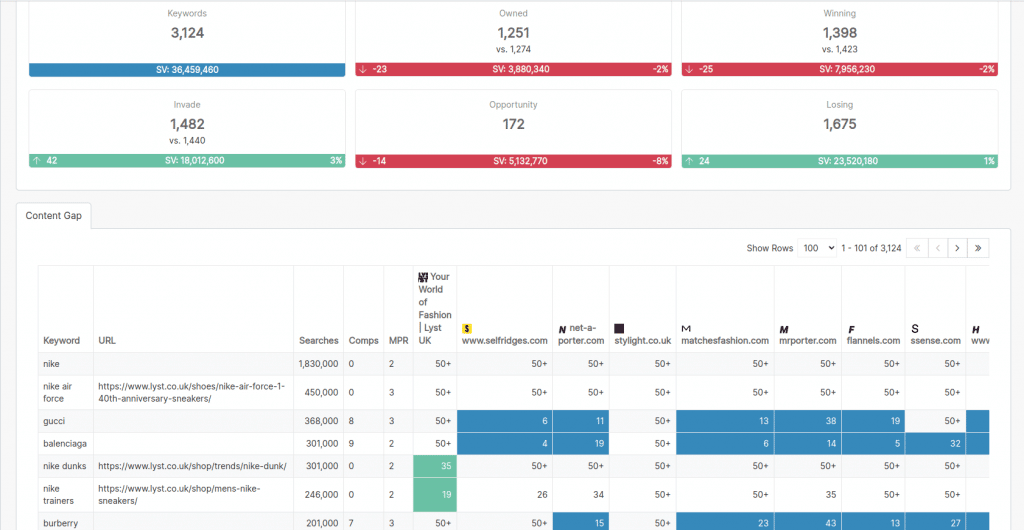
So we built it. Again, in our space, we’re aware of only one other provider that offers this sort of functionality but they are (in our opinion) pretty overpriced for the volumes / value you get. Given our ability to monitor far larger keyword sets for much lower budgets, this tool hits the sweet spot of helping you focus exactly where you need to optimize existing or create new content.
We have some further improvements for this feature coming in 2023.
#12: SERP Rewind Updates
By far, one of our most popular features in the platform is SERP Rewind.
SERP Rewind enables you to see, in a variety of formats (including the original HTML, a detailed view, and our JSON format (which can be consumed via our API)), the changes to your SERPs over time.
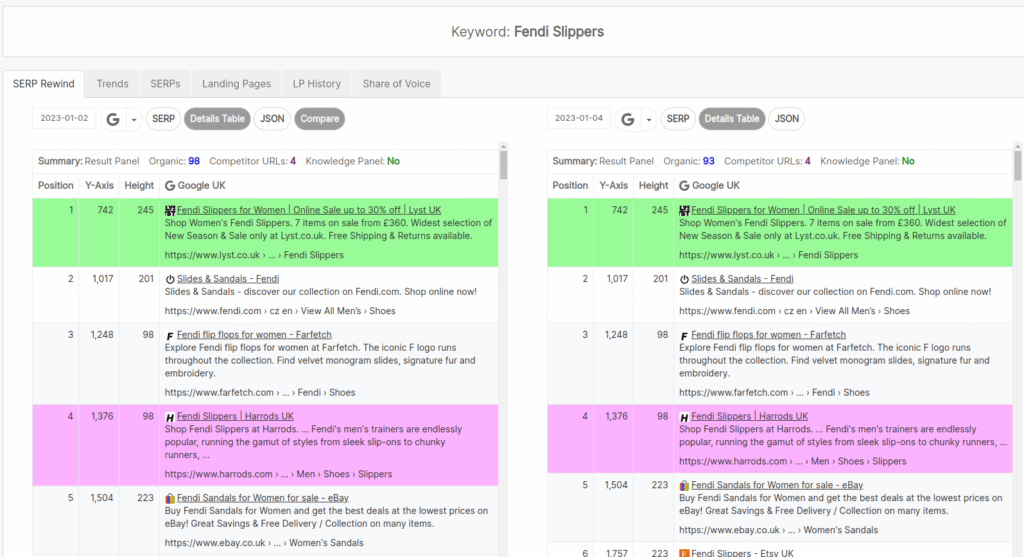
It allows you to choose different keywords, dates, and even search engines to compare visually what exactly is happening with the SERP.
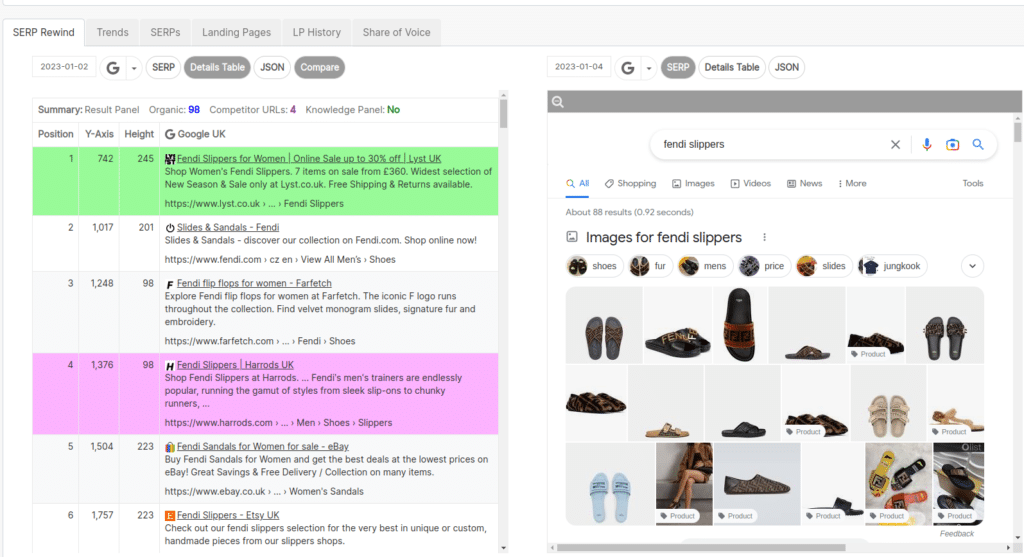
Even though we just released our new version of SERP Rewind in October 2022, we’re actually already working on the next version, which will be released in our v5 UI.
#13: Sitemap Monitoring
I don’t want to give too much away at this point but we’ve been doing some very cool things with sitemaps and monitoring sitemaps. You’ll see some announcements on this later this year.
#14: Keyword and Search Volume inflation detection pipelines and auto-hiding of duplicates
When you get into the keyword volumes that our customers monitor (100K+), you very quickly begin to wonder if you’re monitoring duplicates and / or “useless” keywords in terms of search volume.
As it turns out, this is not an easy question to answer. The first logical step is to simply use some NLP to identify potential duplicates based on stemming / lemmatization.
But you also need to account for:
- ranking URLs
- traffic
- GSC metrics
- search volume
and more.
We spent a few weeks honing our models to the point that we can very effectively help customers flag potential duplicates for further curation and review, or you can just set it it on auto-pilot and trust the system (and it’s quite good).
We then took it a step further to help customers make a decision:
- stop tracking duplicates OR
- keep tracking them because there are ranking variances but hide / ignore duplicates in forecasting models
This goes back to our attempt to build the most accurate and relevant forecasting models in the business.
This is one of those updates that sounds super nerdy and kind of boring but very important in order to build trust in your data.
#15: Large keyword database expansions
This is somewhat of an industry-wide thing but the proliferation of SEO data was incredible in 2022 and this is a trends we expect to continue.
Things were no different at DemandSphere, we acquired so much additional keyword and so many more keyword database expansions that we’re still in the process of organizing it all for use in our primary UI.
For the time being, we provide keyword datasets to our customers who need them for their research and planning purposes that are generally far better curated and of much higher quality than what you get in all of the standard keyword research tools out there.
Our keyword research tool also had some improvements in UX but this is an area we want to do some more work in with two primary goals:
- Improve the richness of the keywords available for research based on these new database additions
- Improve the UX and integration of our research tools through the rest of the platform.
You’ll see some major improvements in 2023 in these areas.
#16: Competitor Discovery improvements
In addition to SERP Rewind, another one of our most popular features is Competitor Discovery.
Competitor Discovery is actually the predecessor feature to SERP Intelligence, and the next version of Competitor Discovery will be based on our SERP Intelligence infrastructure.
This tool enables to you get a market level view, based (importantly) on your keywords, not some random database that you see in the other tools (no offense, these are great / needed too but there is a lot of noise).
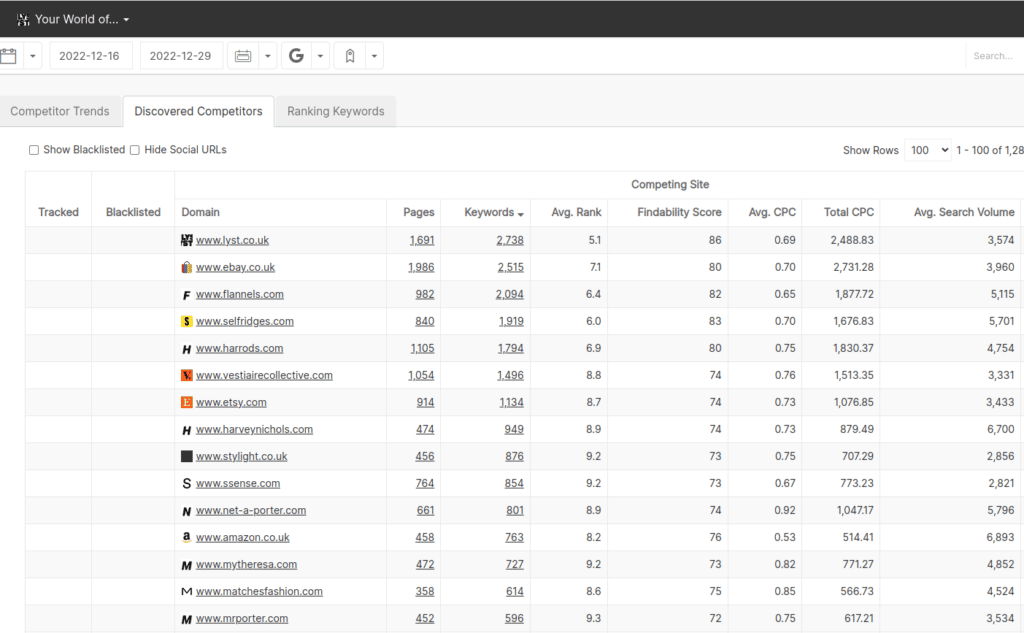
We can go to any depth you monitor in the SERP rankings to quickly see which domains are ranking for your top keywords, which keywords are strong performers for any ad hoc domain, and more.

As we continue to integrate this data with all of the other datasets we’ve mentioned in this article, Competitor Discovery is on its way in to becoming a real-time database of the search engine results for the leading sites on the internet.
#17: URL presence and status within ranking data
This final improvement that we’re going to mention today (although there are more that we didn’t cover here today) seems a little minor but it’s important as well.
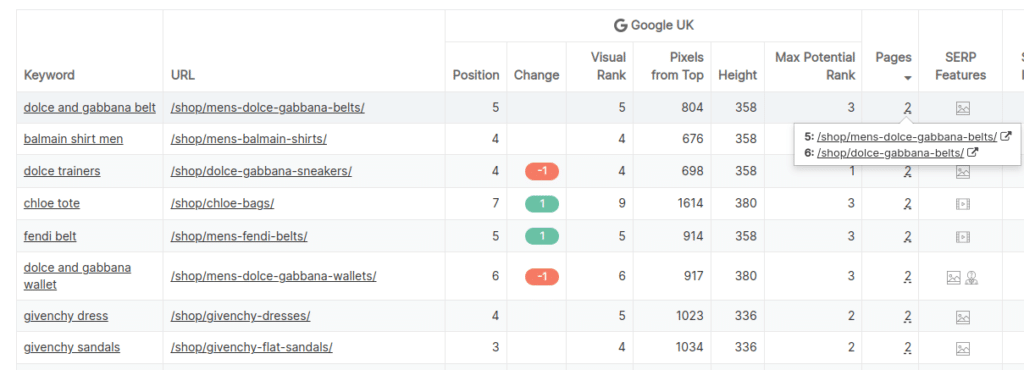
We’ve always maintained rich landing page (LP) history at the individual keyword level so that user can track changes to the ranking URL for a given keyword. As Google has increased the number of ranking URLs from a given domain in a SERP, we recognized the need to track all of those at the keyword reporting levels. This helps in a number of ways:
- Customers can track these URLs both for their own sites and for competitors
- This gets used in our Forecasting feature models
- Enables rich cannibalization reports so that customers can ensure that their actual Preferred Landing Page is the one that ranks the best for targeted keywords
Looking ahead to 2023:
While we don’t want to spill too many secrets, we have some amazing things in store for our customers in 2023.
Here is a small preview of what you can expect to see:
1. Additional data partners
We’re in talks with some leading data vendors that will enable us to pipeline into our platform for our customers, where we can focus on making it actionable in the sets of problems that our customers face.
2. V5 Version of our platform with many significant UI enhancements
We’ve spent the last few years focusing very heavily on building features and new data sets. While we generally get positive reviews on our UI, we also know there is a lot we can improve and that is one of the major areas of focus for the upcoming v5 version of our platform. One of the things we didn’t talk about above is the fact that we have centralized our authentication system in order to enable multiple running versions of our apps from a single login. This gives us a lot of options for new features and also enables us to take an iterative approach to launch v5 screen by screen. This means you’ll get new functionality faster and we get to sidestep all of the risks that come with monolithic version upgrades.
3. New product categories
We’ve always said that SEO is more than just SEO and also that good SEO is good product management, and vice-versa.
With this in mind. we’ll be announcing some new product categories in Q2 that will further enhance the value that the DemandSphere suite can bring to our base.
4. Additional APIs
As an add-on to #3 above, we’ll be adding additional APIs to our platform, even some that don’t have UIs associated with them. We’ve seen an uptick in developer usage of our platform as data engineering continues to take over many areas of digital marketing and anticipate this to continue.
5. Expanded market and research databases
As we mentioned above, there is a massive proliferation of data in the SEO world and we’ll continue to seek out the best sources and work them into our platform.
And much, much more.
Spreading the word
One of the questions we get asked the most when demoing our platform to new prospects is: why haven’t I heard of you before?
And, to be honest, we have flown under the radar for a long time.
With good reason.
We have been extremely busy with our existing customer base and wanted to nail some key advantages before we started spreading the word.
There is still much more we want to do and we’re never satisfied. But we continue to get such a positive response on what we do have, even with the things we know we want to improve, that we feel its important for us to start spreading the word more.
So, one of our key initiatives in Q1 of this year is to launch our new website and get busy on a number of different channels to engage with the great community we have.
If you’re interested in what we’re doing, we’d love it if you’d help to spread the word and give us your feedback.
We’re excited about what this year will bring. Now is a great time to evaluate DemandSphere for adoption within your team.
